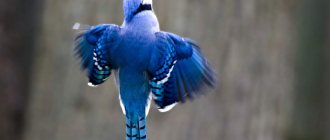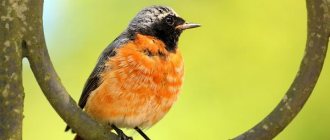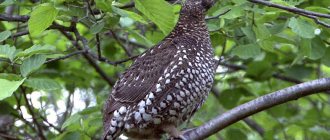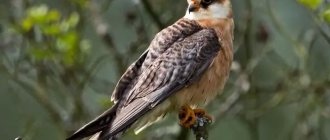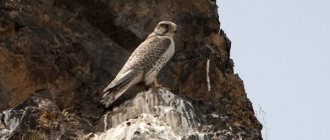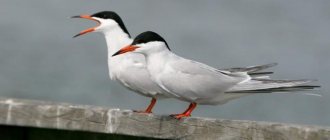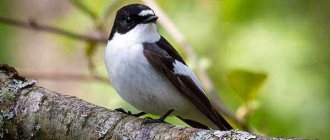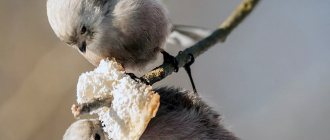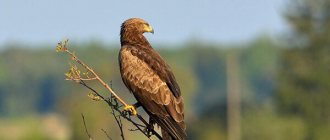The woodpecker is the most hardworking bird in the forest from the woodpecker family of the order Woodpeckers. He is reluctant to fly, but he works hard: a woodpecker in the forest climbs a tree trunk, breaks it with powerful blows of its beak and removes bugs and larvae. The woodpecker has everything adapted for this: a large hard beak, a long sticky tongue with jagged edges, from which the insect can no longer dodge, and a hard tail for support while working. A woodpecker eats up to 1000 bark beetles per day. For his incredible diligence in reducing the population of tree pests, he is called the “forest guard” or “forest doctor.” The drummer woodpecker hides in the foliage thanks to its variegated or green plumage, but in good weather its knocking can be heard in an area up to five kilometers away.
The woodpecker eats harmful bark beetles, which is why it is called the “forest doctor”
Types of woodpeckers and bird lifestyle
Woodpeckers are a large family of more than 200 species. However, in central Europe the following types of woodpeckers are mainly common: green, three-toed, yellow and variegated (the most numerous genus).
The lifestyle of all species is approximately the same.
- Forest workers are constant in their choice of habitat and live sedentary lives.
- The woodpecker is not a migratory bird. During the cold season, he does not leave the area, which he considers his territory.
- A woodpecker winters in the forest in the nesting area.
- In summer, woodpeckers find plenty of insects for themselves, and in winter they extract seeds from cones.
- As a rule, they create stable married couples that stay together for a long time.
The woodpecker is a diurnal bird, and its main activity occurs during daylight hours, but varies depending on the time of year and in hours is on average equal to:
- in winter - 8;
- in spring - 15;
- in summer - 17;
- in autumn - 12.
Moreover, from September to February, woodpeckers work, obtaining food even after sunset. And during the period of incubation of chicks, the daily activity of the female woodpecker reaches 18 hours.
Genus spotted woodpeckers
Spotted woodpeckers are the most numerous and widespread genus. Woodpeckers of this species all wear a red cap, like real craftsmen, and sport contrasting black and white plumage. As a rule, they have red or pink undertails.
The most common type of woodpecker
THIS IS INTERESTING. A woodpecker in the forest will never peck at a healthy tree. Rotten or sick things are more interesting to him, because there is something to profit from there. When climbing a trunk, a woodpecker moves in a spiral and never hangs upside down. This is due to the peculiarity of its vestibular apparatus.
Greater, Middle and Lesser Spotted Woodpeckers
Ornithologists divide these woodpeckers into large (up to 27 cm), medium (up to 22 cm) and small spotted woodpeckers (up to 16 cm). A thin strip of black feathers draws the recognizable “whiskers” of a woodpecker around its white cheeks. The Lesser Spotted Woodpecker has a short stripe, while the Medium Spotted Woodpecker does not have it at all. Male spotted woodpeckers are “red-capped”, this is their main difference from females. In young birds, the marking on the crown is especially bright. All pileated woodpeckers have a strong leaden-black bill.
White-backed Woodpecker
The white-backed woodpecker is similar to the great spotted woodpecker, but is slightly stouter in body, up to 30 cm. Instead of “whiskers” it wears “whiskers”: black stripes stretch from the beak and continue on the sides of the throat. It has a white back, buff belly and pale pink undertail. Males wear a red cap on the crown of their head, females wear a black cap.
The white-backed woodpecker is distinguished by a large white spot on its back
Syrian woodpecker
It was first noticed at the beginning of the 19th century in the then Ottoman Empire and for this it was called Syrian. It was found in southern Bulgaria in 1890, and over the next six decades it reached Austria by 1951. Since then, the range has expanded slightly and now covers Europe, the Balkans and eastern Austria. This species of woodpecker also boasts a black o.
The Syrian woodpecker can now be found in the European part of Russia
It is distinguished by its variegated, drop-shaped wings and off-white belly. Only males sport the signature red stripe on the crown of the head, while females are duller in color.
Yellow-breasted Woodpecker
An indigenous inhabitant of subtropical or tropical forests, therefore it cannot be found in our latitudes. For this type of woodpecker you need to go to India, adjacent Pakistan, as well as to the countries of Southeast Asia. The yellow-breasted bird is indistinguishable from its back from its motley counterparts: the same alternation of black and white feathers and a black stripe on the sides of the neck. In front it is distinguished by a light brown belly. The male has a red head and orange forehead feathers, while the female has a black head.
Pileated Woodpecker
This species of woodpecker is known in Indochina, where it is found in rare pine and deciduous forests. Little studied. Today it is known that the small bird is about the size of a medium-sized spotted woodpecker, and is similar in appearance to the yellow-breasted woodpecker, only its chest is streaked with longitudinal black spots. It prefers beetles, ants and larvae as food.
A little-known inhabitant of Indochina - the spotted-breasted woodpecker
THIS IS INTERESTING. There is a popular proverb: “For every quiet bark beetle there is a woodpecker.”
Red-bellied Woodpecker
Lives in the mountain forests of the lower Himalayas and in the western Chinese provinces. It is found in the countries of Southeast Asia, and also settled in the Primorsky Territory in the 80s. It stands out among other species of woodpeckers due to its red belly color.
The red-bellied woodpecker can be found in Southeast Asia and the Primorsky Territory
In the spring, it drills thin holes in the trunk with its long and sharp beak, and with its tongue, which resembles a brush, it collects and drinks tree sap.
green woodpecker
This woodpecker rarely uses its lead-gray, jackdaw-like beak and seemingly powerful beak for chiselling. He prefers to flutter from the tree to the ground and find food there: ants, snails and even last year’s fruits. Quite large, up to 36 cm, the woodpecker is invisible in the forest among the greenery, because it is camouflaged thanks to the olive color of the upper body, wings and head.
A green woodpecker flies from a tree and finds food on the ground
When the green woodpecker decides to fly, it flaps its wings so that its fluttering in the air waves resembles a dolphin diving into the sea. Males and females have much in common: a black front of the head with a “whisker” from the beak and a narrow contrasting parietal stripe. Only the female’s “whiskers” are black, and the male’s are black and red.
gray woodpecker
Experts consider it a relative of the green woodpecker and a rather rare bird. The woodpecker spends the winter, migrating to places richer in food, which is not typical for woodpeckers. But as soon as it forms a pair, it settles in the selected area. Only the male has a cap on his ash-gray head, and that is only a red spot; the female is a woodpecker without a red cap. He lives well in sparse groves with an abundance of open areas, near clearings and clearings. Often chooses neighborhoods with orchards and parks.
Gray-haired woodpecker finds food on the ground
Its yellow-gray beak does little to hammer, if only into soft, rotten wood. To eat, a gray-haired woodpecker descends to the ground and skips towards its prey like a yard sparrow. He is interested in ant passages, which he examines with his sticky tongue.
Woodpecker
The beak of this woodpecker looks like a real chisel. With it he thoroughly hollows out tall smooth trees, leaving huge deep holes. Black and large, like a raven (up to 49 cm), the woodpecker, with its sticky tongue with jagged inwards, hunts for bark beetles, ants, and can even destroy a bee’s nest.
The plaintive cry of “Drink!” and its drumming can be heard at a distance of up to 4 km
The male is very handsome in a red cap, which is worn from the very beak to the back of the head. The female is duller and only has a spot on her cap. In the forest, the woodpecker screams melancholy and very pitifully in the forest, for which he has earned his nickname.
three-toed woodpecker
This species of woodpecker is very fond of mature coniferous and mixed, often swampy forests of Eurasia. Prefers rotten wood. Its lemon-yellow cap of feathers and large head distinguish it from other species of pileated woodpeckers.
Three-toed woodpeckers can be seen on rotten trees
The female has a silver-gray cap with dark streaks. It appears rather black due to faint white speckles on the back.
Great Pileated Woodpecker
For its small body of 16 cm, this woodpecker has a very long beak. Loves light evergreen and deciduous forests; gardens and bushes are also suitable for him. The sharp-winged woodpecker looks almost like the lesser spotted woodpecker, only this species is larger in size, and it has a large white mark on its back. The back of the male's head is marked on both sides with sparse red feathers, while the female has none at all. We can say that this is a woodpecker without a red cap. There are about 15 subspecies of it. Only one of them lives in the Far East, the rest live in the foothills and lower altitude zone of the Himalayas.
The Great Pileated Woodpecker can be found in the Far East
Yellow-capped Woodpecker
With its small size and golden-yellow feathers on the forehead and crown of the head, this species of woodpecker resembles a songbird. To eat better, he often stays close to orchards and plantations. In the crown of trees it finds remains of fruits, nectar, as well as caterpillars and larvae. Inhabits dry, sparse deciduous forests and bush thickets of Hindustan and Indochina.
Brown-fronted Woodpecker
An upturned beak-chisel with a wide base helps this small (up to 20 cm) bird obtain food. It got its name from the brown feathers on its forehead. It has a common variegated coloration, “mustaches” and a colorful cap that is common to the entire genus. Moreover, the male has a bright lemon-yellow crown and a red nape, while females have both the crown and the nape of a dark yellow color.
The brown-fronted woodpecker has brown feathers on its forehead and a lemon-yellow cap.
An inhabitant of the foothills and a resident of the lower belt of the Himalayas. It is also found in Afghanistan, Pakistan, India and Nepal.
THIS IS INTERESTING. A completely white albino woodpecker was spotted in Uzhgorod. Albino is a rare phenomenon in nature and occurs from a lack of melanin in the body. So the feathers of the albino woodpecker from Uzhgorod lack black pigment. A local photographer managed to take some photos of an albino woodpecker after his daughter told him about a white bird near her house.
Woodpecker
In nature, there is another distant relative of the woodpecker - the glossy woodpecker from the same genus of woodpeckers; in the classification the bird is called a yacamara. It is small, with a long beak and tail. The plumage of the woodpecker has a metallic sheen: the back is green and the belly is red or brown. The male is distinguished by a white spot on his throat. The Yacamara lives in South America and nests in high clayey river banks or in termite mounds, inside which it digs a hollow for itself. The woodpecker feeds on insects, which it catches in flight.
Woodpecker range
The range of the woodpecker family is very wide. According to the landscape, woodpeckers live mainly on the plains and foothills. In the mountains, the woodpecker is a rare visitor and is almost never seen.
- The northernmost populations of woodpeckers live in central Siberia.
- The southernmost ones are in northern Africa, the Caucasus and Asia Minor.
- The bird is found on the islands of the Mediterranean Sea.
- The range of the main European population of woodpeckers extends from the northern regions of Europe, through Russia and to Kamchatka and Sakhalin.
- Spotted woodpeckers even live on the Japanese islands.
Where do woodpeckers live?
In most cases, woodpeckers live in the forest. They adapt wherever there are trees and thrive in the northern taiga, in the mixed forests of Siberia and the Urals, and in the cedar-deciduous forests of the Far East. The main thing for a woodpecker is that there are many diseased trees in the forest.
Woodpeckers are sedentary birds and do not leave the forest area around their nest
- The Great Spotted Woodpecker can be found in ancient parks of large cities; for example, woodpeckers live in the Mikhailovsky Garden and in Sosnovka Park in St. Petersburg.
- Small species, the white-backed woodpecker and the lesser spotted woodpecker, live in low mixed plantings. They will readily occupy forests in the floodplains of lakes and rivers, as well as low-growing alder.
- While the lesser spotted woodpecker never chooses a coniferous forest for nesting, the average spotted woodpecker willingly settles in tall coniferous-deciduous forests.
- The white-backed woodpecker can settle in a forest with coniferous trees if there is a rotting windbreak there. But still, mixed forests are closer to him, especially if they are old birch forests. Doesn't like it when the forest is cleared and improved.
- Zhelna loves mature coniferous forests with tall trees, cedar and spruce forests in the taiga, and beech forests in the foothills.
Natural enemies
The main enemies of woodpeckers are large birds of prey in the regions where they live. But they are almost not afraid of predators. Simply because a fox or a bear will never climb that high.
Photo: community.goodgamestudios.com
Jay (50 photos): description of the bird, what it eats and where it lives
Why does the woodpecker knock?
The knock of woodpeckers is a trill that occurs from rapid blows of the beak on a tree. The woodpecker knocks like a drummer from spring to September. The trill of a drum is their language. Birds knock to communicate important information to each other.
THIS IS INTERESTING. Many people have wondered: why doesn’t the drummer woodpecker get a headache? It turned out that the bones of his skull have a spongy structure and absorb shock. This answer was found by two scientists from the University of California. Ivan Schwab and Philip May received the Anti-Nobel Prize for this discovery in 2006.
- The Great Spotted Woodpecker drums loudly and briefly: six hundredths of a second. The sound is loud at first, then fades away.
- The Lesser Woodpecker likes to knock longer—one and a half seconds, but much quieter.
- The middle woodpecker drums the least often, but he is the most vocal.
- The green woodpecker does not drum at all.
- But the white-backed woodpecker is a loud drummer and does it longer than the great spotted woodpecker. In two seconds it produces more than 30 clearly visible strikes.
- Zhelna drums longer than all woodpecker species, up to three seconds. Its drawn-out knocking can be clearly heard in the forest over long distances up to 4 km.
Features of anatomy
Woodpeckers feed on insects, which they get from wood. This is facilitated by some structural features of the body:
- The woodpecker's beak is chisel-shaped, which makes its strikes on wood more effective.
- The bird's nostrils are protected by densely arranged villi, which prevents dust and small particles formed when chopping wood from entering the respiratory tract.
- The bird's tongue is long, flexible, forked at the end. This feature helps the woodpecker pull out insects from the thickness of the bark.
- The skull bones of woodpeckers have a porous, spongy structure. This structure protects the bird's brain from shocks resulting from numerous blows to the tree.
The paws and tail of woodpeckers perform a supporting function and are well adapted for this: the paws, as a rule, are four-toed, with two fingers facing forward and two back. The only exception to this rule is the three-toed woodpecker. Woodpeckers have smooth plumage. Closer to the tail it becomes rigid, which allows the bird to lean on the tail while sitting on a tree.
Woodpeckers have very pronounced sexual dimorphism , which is expressed, as a rule, in the brighter plumage of males.
When and how does a woodpecker sing?
Most often, the woodpecker sings during the mating season, supplementing the song with drumming to attract attention, but its voice can also be heard all year round and for various reasons: a regular call, warning in a moment of danger, screams during a dispute over territory, in a moment of fright. It has been noticed that males are more vocal than females. Woodpeckers do not sing when they drum.
- The call of the Great Spotted Woodpecker sounds like a short, abrupt “kick.” An alarmed woodpecker will produce a series of “ki-ki-ki.”
- The white-backed woodpecker makes softer and quieter “kick” sounds, but in order to drive away a competitor, the angry bird will produce a stormy long trill “ki-ki-ki”, which will merge into a continuous chirping.
- The green woodpecker is very noisy. In a harsh voice, similar to laughter, he repeatedly repeats the syllables “glue-glue-glue” on various occasions. This squealing can last up to twenty times in a row.
- An excited gray-haired woodpecker makes the sounds “chk-chk-chk”, but for some reason its mating song is melancholy: the woodpecker makes a long series of “kew-kew-kew” sounds, lowering the intonation towards the end of the phrase.
- The call of the woodpecker is melodic: the woodpecker makes the sounds “kru-kru-kru”, and at the end it draws a plaintive long “kli-i-i”, which brings to mind sad thoughts.
THIS IS INTERESTING. To lure birds, ornithologists imitate the voice of the gray woodpecker. Listen to the Great Spotted Woodpecker sing in this video:
Voice
The common spotted woodpecker has the least developed drumming of all woodpeckers of the western Palearctic; for this reason, vocalization is of paramount importance in demonstrative behavior. This is a fairly sociable bird, especially during the breeding season. At the end of winter and spring, you can often hear the mating song - a leisurely series of nasal and hoarse meowing sounds "kick-kick-kirrikikik", somewhat reminiscent of the sounds of friction of an ungreased wooden wheel. Call - rarer single calls of the same tone, similar to the crackling squeal of a jay. Compared to the Lesser Spotted Woodpecker, they are weaker and lower in tone. There is little drumming, and individual beats are clearly audible in the roll. The duration of the knock is comparable to that of the Great Spotted Woodpecker, but it is weaker and not as sharp.
What does a woodpecker eat?
The bird chooses what will be for lunch today according to the season. A woodpecker in the forest jumps along the trunk and with its sensitive hearing catches the slightest movement under the bark. Next comes the beak chisel and long tongue. Insects get stuck in sticky saliva produced by a special tongue gland. The woodpecker slowly examines the tree, after which it flutters to the next one.
The woodpecker leaves deep holes in the trunk with its strong beak
Food in the warm season
In spring and summer, woodpeckers eat animal food in abundance in the forest. Most often, woodpeckers eat bark beetles, leaf beetles, weevils and other wood-dwelling insects and their larvae. In addition, butterflies, pupae, mosquitoes, caterpillars, aphids, centipedes and ladybugs are used as food. Some species of woodpeckers are very fond of ants. The bird feeds on an area of up to 12 hectares of forest and considers it its own territory.
Food in the cold season
In autumn and winter, insects hide, hibernate, and woodpeckers switch to seeds from spruce and pine cones, acorns, nuts, seeds of deciduous trees, and pine buds.
In winter, woodpeckers are not shy about eating at bird feeders.
Woodpeckers are not afraid of humans and fly into bird feeders near their homes to feed. It is rare, but it happens that large species of woodpeckers can offend small songbirds and destroy their nests.
Food of some species of woodpeckers
Green and gray woodpeckers, unlike other species, have adapted to feed under trees. They love to get ants with their sticky tongue, which is long, up to 10 cm. In winter, when everything is covered with snow and insects sleep in the forest, woodpeckers do not give up and dig deep holes in the snow to search the ant passages. In addition, in winter they are saved by rowan fruits.
A woodpecker makes a “forge” in a crack in a dry tree to peel cones.
THIS IS INTERESTING. To get seeds from a cone, a woodpecker sticks it into a hollow or crack in an old stump. With a few blows of its beak, it smashes the cone into pieces and takes out the seeds. A woodpecker can set up up to 50 such “forges” in its feeding territory. But you will use three or four of the most convenient ones. By the end of winter, near such feeders there is a whole heap of thousands of gutted cones.
How woodpeckers breed
In general, woodpeckers are monogamous; the pair does not break up even after the breeding period. Some species mate for one season. However, it is not uncommon for birds to join together in the same pair in the same place the following year. Great spotted woodpeckers resemble butterflies in their mating dance. The male will attract attention with an aggressive cry and loud drumming on the branches. Females drum less often. Lesser spotted and white-backed woodpeckers begin their spring mating songs from late February to June. The middle ones sing from mid-April to early May, their songs resemble meows.
During the mating dance, woodpeckers flutter like butterflies.
Green woodpeckers first chase each other, then sit close on a branch, swing their heads and touch their beaks. If the male feeds the female, it means they have become a couple.
If a male and female white-backed woodpecker like each other, they will knock in a duet, defiantly extend their beak along the trunk, slowly swing with a pendulum and flutter like butterflies.
How birds make a nest
A woodpecker makes a nest in a hollow. The larger the woodpecker, the larger the hollow it will make. As a rule, both partners work on the house. The Great Spotted Woodpecker will choose soft wood for construction. Aspen, alder, beech, birch or poplar are suitable. His hollow will be deep, up to 35 cm. Inside he needs space, so he will expand it to 12 cm. Outside he will leave a narrower entrance, 6 cm. An average woodpecker can make a hollow in a branch, the main thing is that it is soft wood, but sometimes this woodpecker will take last year's nest.
A woodpecker can make a hole in a trunk or branch
The Lesser Spotted Woodpecker, unlike larger subspecies of woodpeckers, will begin to hollow out a hollow in branches or even in a stump and make it to its size - 20 cm, inside -12 cm, entrance - a round hole of 3 cm. A large green woodpecker needs a large house for its nest, it will be 30-50 cm and 15-18 cm in diameter. The woodpecker will definitely pour fine wood litter into the nest.
How a couple incubates eggs
On average, a female woodpecker lays 5-7 white eggs. Their size depends on the type. For example, in a great spotted woodpecker it is 30 by 24 mm, in a medium woodpecker it is 28 by 21 mm, and in a small woodpecker it is 20 by 15 mm. Partners replace each other, but the female sits most closely on the eggs, and the male constantly looks out or leaves for a short time. The chicks hatch on average after 10-16 days.
How a family feeds chicks
Woodpeckers are true partners: they take turns incubating eggs and cleaning the nest, and aggressively drive away other birds. Both parents also warm and feed the offspring. While one gets food, the other sits with the chicks, after which the roles change. The woodpecker flies up to the chicks up to 20 times within an hour, and feeds them up to 300 times a day. Parent woodpeckers never move further than 100–200 m from the nest. 20–28 days after hatching, the chicks try to fly for the first time.
Black woodpeckers are very caring parents
For some time, their parents will feed them. For example, a brood of a green woodpecker, having risen on its wing, is divided into two parts. Some of the chicks fly after the female, others after the male. The family will stay together for another 3–7 weeks, after which it will disperse throughout the forest.
Interesting Facts
- The woodpecker is a noticeable and noisy bird, often lives next to humans and feeds on food waste. But at the same time, the bird prefers to spend time alone; even during the nesting period, males and females often forage for food at different ends of the common territory.
- Woodpeckers use empty cans or pieces of iron as drums to make the drumming sound over long distances - in this way they call other woodpeckers to come to them.
Keeping a woodpecker in captivity
Sometimes woodpeckers are kept in captivity, but not for the sake of their musical voice, like starlings or larks. As a poultry, the woodpecker can be interesting for its high activity and quick adaptation to humans: it will peck food from your hand within a month.
Please note that keeping a woodpecker in the house is difficult. A woodpecker in nature constantly chisels wood; it is necessary to give it the same opportunity in captivity. When there is nothing to peck in the cage, the woodpecker quickly makes short work of the bars made of wood and plastic, and can break its beak on iron bars.
A woodpecker in the forest constantly moves vertically along the trunk, so it needs a high vertical cage, and it is best to place the woodpecker in an outdoor enclosure. The bigger it is, the better. You should not put other woodpeckers in a cage or enclosure, even a female, because at the end of the mating season they will begin to argue over territory. Inside the cage, you need to place tree trunks vertically, and also take care of the “forge”: a crevice in the tree where the woodpecker can insert pine cones.
What to feed and is it possible to breed in captivity?
The woodpecker needs to be fed 2 times a day, in addition, during the day he should have plenty of cones and nuts for hollowing and drinking water. The woodpecker needs animal and plant food:
- "Nightingale mixture." Finely grated raw carrots, eggs and boiled cottage cheese.
- Animal food. Ant eggs, bark beetles and larvae, grasshoppers and dragonflies in summer.
- Plant food. Grain, seeds, cones, nuts.
Breeding woodpeckers in captivity is almost impossible. During the mating season in nature, a woodpecker chases a female throughout the forest, flying long distances; without this game they will not become a couple, and in captivity they will not have this opportunity, even in an aviary.
Woodpeckers are not sold in pet stores; they are caught in the forest: either they set a trap at the woodpecker’s “forge”, or they catch fledged but not flying chicks (in the latter case, the bird will quickly become tame). It should be noted that woodpeckers are not caught professionally, so it is not possible to describe proven and safe methods for catching woodpeckers.
How long does a woodpecker live?
On average, the Great Spotted Woodpecker, the most common species, lives 9–10 years. Large species, the common woodpecker and the green woodpecker, live up to seven years. There is a known case in which a woodpecker lived for 12 years and 8 months in Sweden. The longest age of a woodpecker - 14 years - was observed in Finland.
Ancient peoples worshiped the cult of the woodpecker as the patron of fertility and guardian of trees
THIS IS INTERESTING. Having studied the structure of a bird's skull, scientists have invented a shock-absorbing case for modern instruments. The overload that such a housing can withstand is 60,000 g. For comparison: the emergency black box of an airplane can withstand a shock load of only 1000 g.
Population and conservation status
The number and size of populations of individual species in different areas of their range may vary for a number of reasons. In general, the woodpecker population, despite global environmental deterioration and predator invasions, remains at a good level. The status it has been given is “Least Concern”. According to this status, the woodpecker family thrives on the globe.
However, there are species of woodpeckers that do not live in the European zone and therefore are not considered in this article, which have long been listed in the International Red Book:
- Like the critically endangered: imperial, ivory-billed, Okinawan woodpecker.
- Endangered: Yellow-rumped Woodpecker.
- As being in a vulnerable position: Great Müllerian woodpecker.
The Okinawan woodpecker is on the verge of extinction.
Also, several species of woodpeckers are listed in the Red Book of the Moscow Region. According to this document, the number of green woodpeckers is declining, and the hoary and three-toed woodpeckers are considered rare.
Danger
If he sees danger, he does not immediately fly away, but hides behind the back of the trunk and sits there, periodically poking his head out. If a predator creeps up very close, only then does the woodpecker flap its wings and fly away from the enemy. As you can imagine, this is an incomplete description of the woodpecker. Since there is a wide variety of these birds, each species has its own habits, habits, and so on. These creatures are defenseless, so they are pursued by hawks, falcons, eagle owls and other similar predators. Magpies destroy their nests. Therefore, woodpeckers know very well places in their forest where they can hide from predators. Thanks to this, they feel comfortable in this area, react quickly to any type of danger, and have a good understanding of how to get food.
Legends and beliefs
According to collectors and researchers of legends, ancient peoples worshiped the cult of the woodpecker. The bird was a symbol of fertility, as well as the patron of heavenly fire, which he gave to people. The woodpecker was revered as a healer of the forest and guardian of trees. The woodpecker is mentioned in ancient mythology by the ancient Romans as the forest deity Picus. In the legend of the founders of Rome, a woodpecker brings food in its beak to the twins.
For many peoples, the woodpecker's drumming was prophetic and meant a call to war or a warning of natural disasters, so the bird was correlated with Mars. In almost all Slavic beliefs, the woodpecker is associated with fire. One of the reasons, of course, is the red cap.
In the beliefs of many peoples, the woodpecker is associated with fire due to its red fire cap
- In the Vologda region, a woodpecker perched on a hut was a sign of a fire.
- In the Russian North, it was noted that a tree that was sharpened by a woodpecker in the forest would only be suitable for firewood.
- In the Slavic tradition there is an interesting legend about how God punished a man and turned him into a woodpecker for working with an ax on a tree on a holiday. Since then the woodpecker has been knocking seven days a week.
- There is a popular belief about the herb that opens locks. The woodpecker brings it to its nest. The main thing is to prevent the bird from flying into the hollow and distract it with a red scarf, onto which it will throw grass, as if on fire. The grass should be held in the right hand. They believed that if you just touch the lock with your hand, it will open by itself.
- According to another legend, when birds were digging rivers, God became angry with the woodpecker. Zhelna didn’t help anyone. For this, God forbade her to touch the water. Since then, Zhelna can only drink rain water and that is why she screams so pitifully, calling for rain: “Drink! Drink!". Among the people, the cry of the yellow one is a harbinger of rain.
THIS IS INTERESTING. In colloquial language, the word “woodpecker” is used to address not very smart people who, moreover, repeat their misconceptions, which, of course, has nothing to do with this hardworking wonderful bird.
